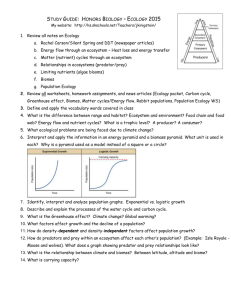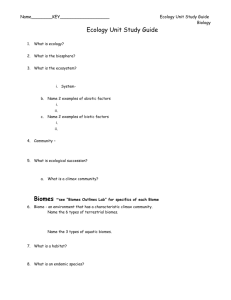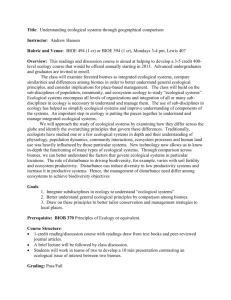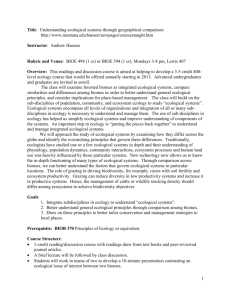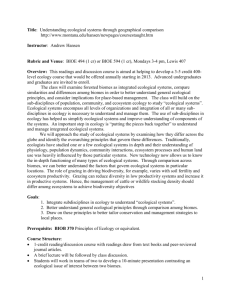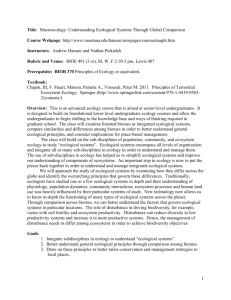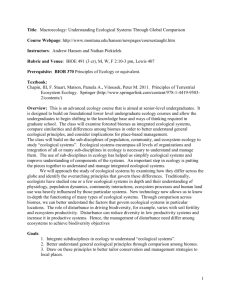Title: Macroecology: Understanding Ecological Systems Through
advertisement
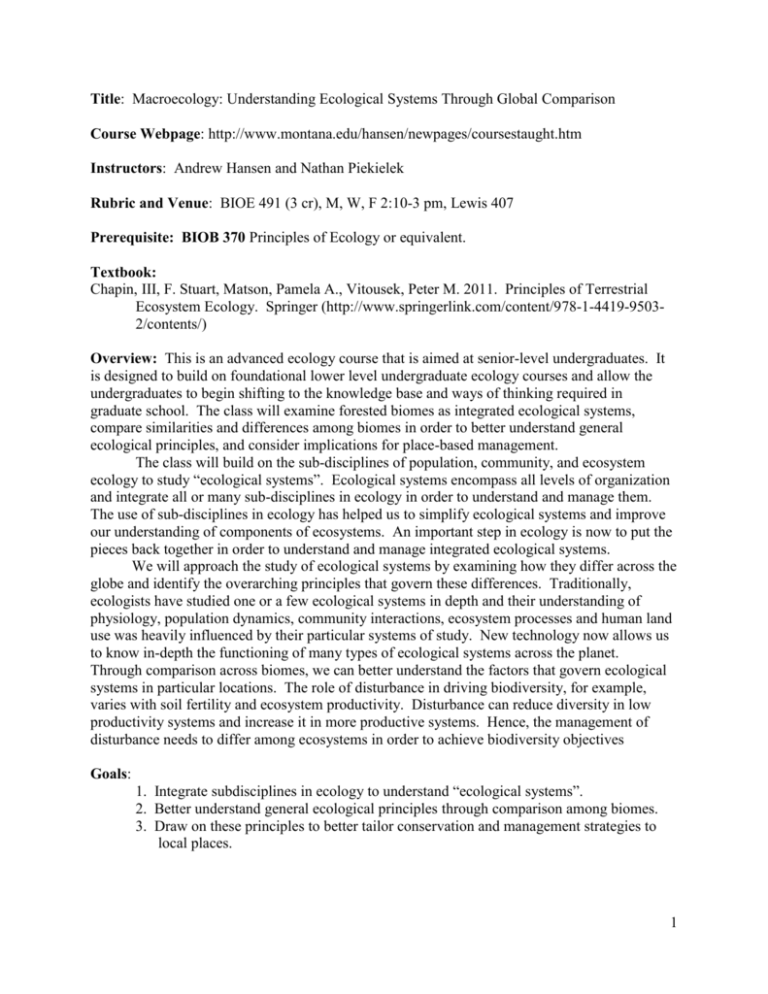
Title: Macroecology: Understanding Ecological Systems Through Global Comparison Course Webpage: http://www.montana.edu/hansen/newpages/coursestaught.htm Instructors: Andrew Hansen and Nathan Piekielek Rubric and Venue: BIOE 491 (3 cr), M, W, F 2:10-3 pm, Lewis 407 Prerequisite: BIOB 370 Principles of Ecology or equivalent. Textbook: Chapin, III, F. Stuart, Matson, Pamela A., Vitousek, Peter M. 2011. Principles of Terrestrial Ecosystem Ecology. Springer (http://www.springerlink.com/content/978-1-4419-95032/contents/) Overview: This is an advanced ecology course that is aimed at senior-level undergraduates. It is designed to build on foundational lower level undergraduate ecology courses and allow the undergraduates to begin shifting to the knowledge base and ways of thinking required in graduate school. The class will examine forested biomes as integrated ecological systems, compare similarities and differences among biomes in order to better understand general ecological principles, and consider implications for place-based management. The class will build on the sub-disciplines of population, community, and ecosystem ecology to study “ecological systems”. Ecological systems encompass all levels of organization and integrate all or many sub-disciplines in ecology in order to understand and manage them. The use of sub-disciplines in ecology has helped us to simplify ecological systems and improve our understanding of components of ecosystems. An important step in ecology is now to put the pieces back together in order to understand and manage integrated ecological systems. We will approach the study of ecological systems by examining how they differ across the globe and identify the overarching principles that govern these differences. Traditionally, ecologists have studied one or a few ecological systems in depth and their understanding of physiology, population dynamics, community interactions, ecosystem processes and human land use was heavily influenced by their particular systems of study. New technology now allows us to know in-depth the functioning of many types of ecological systems across the planet. Through comparison across biomes, we can better understand the factors that govern ecological systems in particular locations. The role of disturbance in driving biodiversity, for example, varies with soil fertility and ecosystem productivity. Disturbance can reduce diversity in low productivity systems and increase it in more productive systems. Hence, the management of disturbance needs to differ among ecosystems in order to achieve biodiversity objectives Goals: 1. Integrate subdisciplines in ecology to understand “ecological systems”. 2. Better understand general ecological principles through comparison among biomes. 3. Draw on these principles to better tailor conservation and management strategies to local places. 1 Course Structure: Lectures on key principles and geographic comparison Virtual field trips of global forest biomes Student lead active learning projects Grading: Grading will be based on 3 exams (100 points each) and 9 student projects (20 points each) for a total of 480 points. Student Projects: Students will be expected to work individually and in small groups to complete a series of weekly projects throughout the semester. Projects will include reflection on prior coursework in ecology, written response to assigned readings, presentation of reading material and leadership of class discussion, preparation and presentation of virtual field trips for the rest of the class, and others to be determined as the semester progresses. Anticipated Learning Outcomes: 1. Ecology Department majors will be able to synthesize among sub-disciples such as animal behavior, population ecology, community ecology, and ecosystem ecology to understand integrated ecological systems. 2. Students will better understand fundamental principles of ecology by examining how these principles are manifest in the different terrestrial biomes of the world. 3. Students will be able to draw on these general principles and knowledge of terrestrial biomes to better tailor conservation and management strategies to local ecosystems. 4. Students will transition from ways of thinking and ecological knowledge typical of advanced undergraduate students to those expected for beginning graduate students. 5. Students will demonstrate outcomes 1-4 in three examinations and in a final written project. 2 Date Schedule Topic and Tentative Reading Week 1: Introduction Jan 9 Class Orientation Evaluation of Current Knowledge Jan 11 Student projects assigned Virtual Field Trip – Temperate Rain Forests Week 2: Conceptual Models of Ecological Systems Chapin, III, F. Stuart, Matson, Pamela A., Vitousek, Peter M. 2011. Principles of Terrestrial Ecosystem Ecology. Springer, New York. Chapter 1. Introduction, pgs 3-12.25, 14-17.5, 21.5-22. Pickett, S.T.A., J. Kolasa, C.G. Jones. 2007. Ecological Understanding: The Nature of Theory and the Theory of Nature. Elsevier, Boston. Chapter 1 Integration in Ecology, pgs 3-18.25, 26.5-32. Jan 14 Conceptual Models of Ecological Systems I Jan 16 Conceptual Models of Ecological Systems II Jan 18 Student projects due from previous week Virtual Field Trip – Montane Temperate Forest Week 3: Terrestrial forest biomes of the world Chapin, III, F. Stuart, Matson, Pamela A., Vitousek, Peter M. 2011. Principles of Terrestrial Ecosystem Ecology. Springer, New York. Chapter 2. Earth’s climate system, pgs 23-26, 30-35.5, 38-41.5, 50.5-59.75. Jan 21 No Class, Martin Luther King Holiday Jan 23 Terrestrial forest biomes of the world I Jan 25 Student projects due and assigned Terrestrial forest biomes of the world II 3 Week 4: Primary productivity: controls, patterns, consequences Chapin, III, F. Stuart, Matson, Pamela A., Vitousek, Peter M. 2011. Principles of Terrestrial Ecosystem Ecology. Springer, New York. Chapter 5. Carbon inputs to ecosystems, pgs 123-128, 140-147. Jan 28 Lecture I Jan 30 Lecture II Feb 1 Student projects due from previous week Virtual Field Trip – African Savanna Week 5: Primary productivity: comparison among biomes Running, S. W., R. R. Nemani, F. A. Heinsch, Z. Zhao, M. Reeves, and H. Hashimoto. 2004. A continuous satellite derived measure of global terrestrial primary production. BioScience 54:547–560. Read pgs: 547-548 (omit Relating NDVI, APAR…), 550-559. Huston, M. A., and S. Wolverton. 2009. The global distribution of net primary production: resolving the paradox. Ecological Monographs. 79(3), 2009, pp. 343–377. Read pgs: 343-343 (Introduction); 346 (Patterns of Terrestrial NPP and Nutrients – 350 (Omit Addressing the Paradox); 351 (Direct Measurements of NPP in Forest Ecosystems) – 353; 368-369. Chapin et al. 2011. Chapter 5 Pgs. 153-154. Chapter 6. Pgs. 169.5–172.25, 177.5–180.5. Feb 4 Lecture I Feb 6 Lecture II Feb 8 Exam I Student projects assigned 4 Week 6: Home range size and body size Harestad, A. S., and F. L. Bunnell. 1979. Home range and body weight-A reevaluation. Ecology 60:389-402. Herfindal, I., J. D. C. Linnell, J. Odden, E. B. Nilsen, and R. Andersen. 2005. Prey density, environmental productivity and home-range size in the Eurasian lynx (Lynx lynx). Journal of Zoology 265: 63–71. Nilsen, E. B., I. Herfindal, J. D. C. Linnell. 2005. Can intra-specific variation in carnivore home-range size be explained using remote-sensing estimates of environmental productivity? Ecoscience 12:68-75. Feb 11 Lecture I Feb 13 Lecture II Feb 15 Student projects assigned and due from previous week Virtual Field Trip – Temperature Deciduous Forest Week 7: Herbivore abundance and richness Oiff, H., M. E. Richie, and H. H. T. Prins. 2002. Global environmental controls of diversity in large herbivores. Nature 415:901-904. Feb 18 No Class, Presidents’ Day Holiday Feb 20 Lecture I Feb 22 Student projects assigned and due from previous week Week 8: Habitat complexity: controls, patterns, consequences Chapin, III, F. Stuart, Matson, Pamela A., Vitousek, Peter M. 2011. Principles of Terrestrial Ecosystem Ecology. Springer, New York. Chapter 13. Landscape heterogeneity and ecosystem dynamics, pgs 369-372. Brokaw, N. and R. Lent. 1999. Vertical structure. Pgs. 373-300 in M.L. Hunter, ed., Maintaining Biodiversity in Forest Ecosystems. Cambridge University Press. Feb 25 Lecture I Feb 27 Lecture II Mar 1 Student projects assigned Virtual Field Trip – Boreal Forest 5 Week 9: Habitat complexity: Comparison among biomes – Student lead discussion. Verschuyl, J.P., A.J. Hansen, D.B. McWethy, R. Sallabanks, R.L. Hutto. 2008. Is the effect of forest structure on bird diversity modified by forest productivity? Ecological Applications 18(5), 1155-1170. Hansen, A. J., L. Baril, J. Watts, F. Kasmer, T. Ipolyi, R. Winton. In Prep. Towards generality in fragmentation theory: Does ecosystem biomass predict edge effects? Forest Ecology and Management. Mar 4 Lecture I Mar 6 Lecture II Mar 8 No Class Spring Break Week Mar 11-15 Spring Break Week 10: Community diversity: controls, patterns, consequences, comparisons among biomes Gaston, K. J. 2000. Global patterns in biodiversity. Nature 405:220–227. Mar18 Lecture I Mar 20 Lecture II Mar 22 Exam II Week 11: Community diversity: Comparisons among biomes Cardinale BJ, Hillebrand H, Harpole WS, Gross K, Ptacnik R. 2009. Separating the influence of resource ‘availability’ from resource ‘imbalance’ on productivity–diversity relationships. Ecology Letters 12: 475–487. Mar 25 Lecture I Mar 27 Lecture II Mar 29 No Class, University Day Week 12 Climate change: controls, patterns, consequences McCarthy, J.J. 2009. Reflections on: our planet and its life, orgins, and futures. Science 326:1646-1655. Apr 1 Lecture I Apr 3 Lecture II Apr 5 Student projects assigned Virtual Field Trip – Tropical Rain Forest 6 Week 13 Spatial Variation in Climate Change and Ecosystem Sensitivity: Implications for Management Keane, R.E., P.F. Hessburg, P.B. Landres, F.J. Swanson. 2009. The use of historical range and variability (HRV) in landscape management. Forest Ecology and Management 258:1025-1037. Hobbs, R.J., Cole, D.N., Yung, L., et al., 2010. Guiding concepts for park and wilderness stewardship in an era of global environmental change. Frontiers in Ecology and the Environment 8:483-490. Caro, T., J. Darwin, T. Forrester, C. Ledoux-Bloom, C. Wells. 2011. Conservation in the Anthropocene. Conservation Biology Apr 8 Lecture I Apr 10 Lecture II Apr 12 Student projects assigned and due from previous week Virtual Field Trip – Aquatic fluvial systems Week 14 Human land use: Comparisons among Biomes Luck, G. W., L. Smallbone, S. McDonald, and D. Duffy. 2010. What drives the positive correlation between human population density and bird species richness in Australia? Global Ecology and Biogeography 19:673–683. Apr 15 Lecture I Apr 17 Lecture II Apr 19 Student projects due from previous week Week 15 Synthesis: Grouping Biomes based on ecological properties Hansen A.J. In Review. Ecosystem energy as a framework for prioritizing conservation vulnerabilities and management strategies. Unpublished manuscript. Pgs 1-36 Apr 22 Lecture I Apr 24 Lecture II Apr 26 Review for final Finals Week Apr 29 Comprehensive Final 8:00-9:50 am 7

